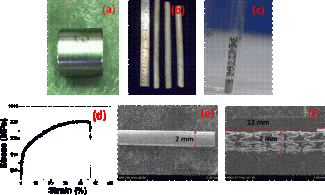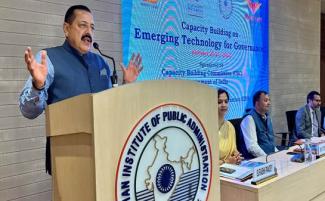
इस समाचार को हिन्दी में पढ़े आगे....
Scientists at the International Advanced Research Centre for Powder Metallurgy and New Materials (ARCI) and Sree Chitra Tirunal Institute of Medical Sciences, Thiruvananthapuram both autonomous institutes under the Department of Science & Technology (DST) have jointly developed new generation Iron-Manganese based alloys for biodegradable metal implants for use in humans.
Biodegradable materials (Fe, Mg, Zn, and polymer), which can participate in the healing process and then degrade gradually by maintaining the mechanical integrity without leaving any implant residues in the human body are better alternatives to currently used metallic implants which remain permanently in the human body and can cause long-term side effects like systemic toxicity, chronic inflammation, and thrombosis.
The ARCI team employed both conventional melting and powder metallurgy techniques in manufacturing of the new Fe-Mn based biodegradable alloys and stent having dimensions as Diameter: 2 mm, Length: 12 mm and Wall thickness: 175 µm.
Iron-Manganese based alloy Fe-Mn (having Mn composition of more than 29% by weight) is a promising biodegradable metallic implant which exhibits single austenitic phase (non-magnetic form of iron) with MRI compatibility.
The Fe-Mn alloy produced at ARCI exhibited 99% density with impressive mechanical properties and behaved as a nonmagnetic material even under a strong magnetic field of 20 Tesla. These properties are comparable to presently used permanent Titanium (Ti) and stainless-steel metallic implants. The alloy also showed a degradation rate in the range of 0.14-0.026 mm per year in the simulated body fluid, which means that the Fe-Mn alloy exhibits mechanical integrity for 3-6 months and completely disappears from the body in 12-24 months.
During the degradation process, calcium phosphate deposits on the implant due to local alkalization and saturation of calcium and phosphate, allow cells to adhere onto the surface to form tissues.
The team is making further efforts to achieve control in corrosion rates through alloying addition and surface engineering and to employ advanced manufacturing processes like additive manufacturing to realize complicated shapes.
Based on the impressive results, the ARCI team is certain that the newly developed Fe-Mn based alloys are suitable for biodegradable stent and orthopedic implant applications. Invivo and in-vitro studies are being planned at Sri Chitra Tirunal Institute of Medical Sciences by the team.
For more details, contact Dr. Kaliyan Hembram ([email protected])
एआरसीआई के वैज्ञानिकों ने स्वाभाविक तरीके से सड़नशील उन्नत धातु इम्प्लांट बनाया
टीम का मानना है कि नई विकसित मिश्र धातुएं स्वाभाविक रूप से सड़नशील स्टेन्ट और ऑर्थोपेडिक इम्प्लांट्स अनुप्रयोगों के लिए उपयुक्त
विज्ञान एवं प्रौद्योगिकी विभाग के तहत स्वायत्त संस्थानों चूर्णिक धातु कर्म एवं नई सामग्री यानी पाउडर मेटलर्जी एंड न्यू मेटीरियल्स के लिए अंतरराष्ट्रीय उन्नत शोध केंद्र(एआरसीआई) और श्री चित्रा टिरुनल इंस्टिट्यूट ऑफ़ मेडिकल साइंसेस, तिरुअनंतपुरम के वैज्ञानिकों ने संयुक रूप से मानव शरीर में इस्तेमाल होने योग्य स्वाभाविक रूप से सड़नशील धातु का इम्प्लांट बनाने के लिए लौह- मैंगनीज से युक्त उन्नत मिश्र धातु बनाया है।
स्वाभाविक रूप से सड़नशील सामग्री (लौह, मैंगनीज जिंक और पॉलीमर) उपचारात्मक प्रक्रिया में भाग ले सकते हैं और फिर मानव शरीर में कोई इम्प्लांट अवशेष छोड़े बिना शरीर की संरचना को बरकरार रखते हुए धीरे-धीरे नष्ट हो जाते हैं। ये सामग्री अभी इस्तेमाल हो रहे धातुओं के इम्प्लांट का बेहतर विकल्प हैं जो स्थायी रूप से मानव शरीर में पड़े रहते हैं और धीरे-धीरे विषाक्तता, स्थायी सूजन एवं फ्रोमबाउसिस जैसे साइड इफेक्ट्स का कारण बन जाते हैं।
एआरसीआई की टीम ने स्वाभाविक रूप से सड़नशील लौह मैंगनीज युक्त मिश्र धातु और स्टेन्ट बनाने में दोनों पारंपरिक मेल्टिंग और पाउडर मेटलर्जी तकनीक का इस्तेमाल किया है। स्टेन्ट का आकार इस प्रकार है: व्यास 2 एमएम, लंबाई 12 एमएम, वॉल की मोटाई 172 म्यूएम।
लौह और मैंगनीज युक्त मिश्र धातु लौह- मैंगनीज (भार के संदर्भ में मैंगनीज धातु 29 प्रतिशतसे अधिक) एक भरोसेमंद स्वभाविक रूप से सड़नशील धातु का इम्प्लांट है जो एमआरआई के अनुकूल एकल ऑस्टेनाइटी फेस (लोहे का गैर चुंबकीय प्रारूप) दर्शाता है।
एआरसीआई में बनाए गए लौह- मैंगनीज मिश्र धातु ने प्रभावी यांत्रिकी गुणों के साथ 99 प्रतिशतघनत्व दर्शाया और 20 टेस्ला के चुंबकीय क्षेत्र में भी गैर चुंबकीय सामग्री की तरह व्यवहार किया। इसके ये गुण अभी इस्तेमाल हो रहे स्थाई टाइटेनियम (टीआई) और स्टेनलिस स्टील धातु के इम्प्लांट से तुलना करने योग्य हैं। इस मिश्र धातु ने कृत्रिम काया द्रव्य में सालाना 0.14 से लेकर 0.026 एमएम के दायरे में विघटन दर भी प्रदर्शित किया। इसका मतलब है कि लौह मैंगनीज मिश्र धातु 3 से 6 महीने के लिए यांत्रिकी समग्रता दिखाता है और 12 से 24 महीने में शरीर से पूरी तरह गायब हो जाता है।
विघटन प्रक्रिया के दौरान स्थानिक क्षारियन और कैल्शियम एवं फॉस्फेट की परिपूर्णता की वजह से इम्प्लांट पर कैल्शियम फॉस्फेट जम जाता है, इससे कोशिकाएं उत्तक बनाने के लिए सतह से चिपक जाती हैं।
एआरसीआई की टीम इसमें कुछ अतिरिक्त धातु मिलाकर एवं सर्फेस इंजीनियरिंग के जरिए इसके विनाशन दर पर नियंत्रण हासिल करने के लिए अभी और कोशिश कर रही है। टीम इसके उन्नत निर्माण प्रक्रिया को भी लागू करने की कोशिश में है।
इन प्रभावशाली नतीजों के आधार पर एआरसीआई की टीम इस बात को लेकर आश्वस्त है कि यह नई लौह-मैंगनीज युक्त मिश्र धातु स्वाभाविक रूप से सड़नशील स्टेन्ट और ऑर्थोपेडिक इम्प्लांट अनुप्रयोगों के लिए उपयुक्त है। श्री चित्र टिरुनल इंस्टीट्यूट ऑफ मेडिकल साइंसेज में टीम द्वारा इस पर अभी और अध्ययन करने की योजना बनाई जा रही है।
इस बारे में विस्तृत जानकारी के लिए डॉ. कालियन हेम्ब्राम ([email protected]) से संपर्क कर सकते हैं।











